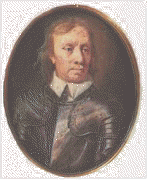| James Stuart was a Scottish Catholic who
believed in the "Divine Right" to rule as he
pleased. This brought him into conflict with the English
Parliament. The failed Catholic Gunpowder Plot to blow up
Parliament in 1605 led to anti catholic riots. The
failure of both James and his son Charles I to understand
the English tradition of parliamentary liberty led
eventually to civil war |
 |
| |
|
 |
James died unlamented in 1625.
Charles I immediately came in to conflict with
Parliament. He tried to rule without summoning
parliament for 11 years, but eventually ran out
of money,and summoned Parliament in 1640 |
| |
|
|
| Parliament was naturally peeved
about his neglect of their rights. They refused
him money, and the country split between
supporters of the king (blue on map left) and
supporters of parliament (red on the map) |
 |
| |
|
|
|
|
 |
|
|
The first major Engagement of the Civil
War was at Edgehill in the Cotswolds on 1642. Indecision
among the Royalists and the moulding of the New Model
army by the parliamentarians led to Parliament gaining
the upper hand, and by 1645 Cromwell won the decisive
Battle of Naseby. Charles was captured and put on trial
for treason in 1649. He refused to recognise the court,
but was regardless found guilty. 59 republicans signed
the death warrant (above), and after the restoration
Charles II prosecuted those that he could. |
| Oliver Cromwell and the army emerged as
the power in the land. Cromwell dissolved parliament with
the words "Depart I say, and let us have done with
you. In the name of God , go!" It was the start of
England's only period of dictatorship Cromwell was unable
to find anything to replace the monarchy. When he died in
1658 his son Richard suceeded him, but "Tumbledown
Dick" was not a man to rule Britain, and in 1660
Charles II was restored to the throne his father had died
for. |
|
| |
|



